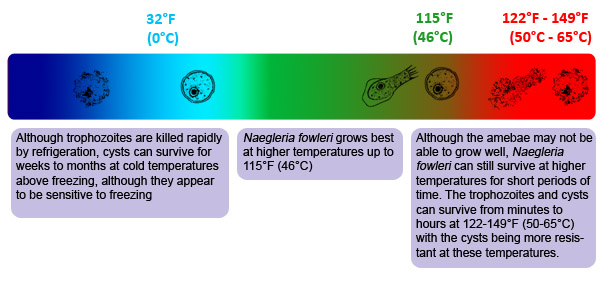Habitat
Naegleria fowleri is a very unique organism..
This species lives in specific environments but within those
specific environments there are many types that N. fowleri
occupy. N.fowleri does better in certain environments
and also has adapted to different habitats the organism normally
does not live in. This organism is also not the only species to
occupy the habitats N. fowleri inhabit.
First N. fowleri live in a certain type of environment
which must be water, soil, or sediment (Martinez and Govinda
2003). Soil and sediment are straight forward but there are
certain kinds of water that this organism can live in and cannot
live in (Martinez and Govinda 2003). For example N. fowleri
can occupy fresh water, thermal discharges of power plants,
heated swimming pools, hydrotherapy, remedial pools, and sewage
(Martinez and Govinda 2003). One water environment that N.
fowleri cannot inhabit is treated water also known as
chlorine (Martinez and Govinda 2003). This species is usually
found in summer months because this is the time people usually
come in contact with N. fowleri and get infected
(Martinez and Govinda 2003). Even though this lineage is mostly
found in the summer months it can be found throughout the whole
year (Chen 2013).
Secondly, since N. fowleri is found in such common
habitats, the species is found all around the world in all of
the wide range of habitats (Chen 2013). For example this lineage
has been found in North America, mostly in the southern states,
Mexico, Europe, Australia, Asia, and other places too (Chen
2013). Scientists found this species in all of these places
because those are the places where people got infected with
Primary Amebic Meningocephalitis (Chen 2013). This is the
infection people get from N. fowleri and is also known as
PAM (Chen 2013). Also N. fowleri can withstand hot
temperatures up to 45.8ᵒC which is 114.44ᵒF (Chen 2013). That is
an incredibly hot environment and many species cannot live in
that warm of conditions (Chen 2013). Since this species can be
found in that warm of an environment N. fowleri have been
found in hot springs (Chen 2013). Since N. fowleri can
withstand such heat they are known to be able to withstand
extreme environments too (Chen 2013).
 Thirdly, N. fowleri may have a variety of habitats but
the species does better in certain types of habitats than other
types (Martinez 1996). N. fowleri succeeds the most in
the tropics and are more common in fresh warm water (Martinez
1996). Since this species does best in warm water and in the
tropics N. fowleri it raises the question why are they
not only in those environments but the species were able to
adapt to these other type of environments (Martinez 1996). This
species is usually not found in chlorinated swimming pools but
if the pools are not properly chlorinated at all times it is
possible for the N. fowleri to be able to succeed and
live in that environment (Martinez 1996). Another unique place
this lineage has been found before is an air conditioning unit
(Martinez 1996). This was very unique because it is not a soil,
sediment, or a water environment (Martinez 1996). Since N.
fowleri were found in an air conditioning unit it just shows
how adaptive this organism truly is (Martinez 1996). N.
fowleri have to get to all of these environments somehow and
one way scientists think it travels is when it is in cyst form
(Martinez 1996).
Thirdly, N. fowleri may have a variety of habitats but
the species does better in certain types of habitats than other
types (Martinez 1996). N. fowleri succeeds the most in
the tropics and are more common in fresh warm water (Martinez
1996). Since this species does best in warm water and in the
tropics N. fowleri it raises the question why are they
not only in those environments but the species were able to
adapt to these other type of environments (Martinez 1996). This
species is usually not found in chlorinated swimming pools but
if the pools are not properly chlorinated at all times it is
possible for the N. fowleri to be able to succeed and
live in that environment (Martinez 1996). Another unique place
this lineage has been found before is an air conditioning unit
(Martinez 1996). This was very unique because it is not a soil,
sediment, or a water environment (Martinez 1996). Since N.
fowleri were found in an air conditioning unit it just shows
how adaptive this organism truly is (Martinez 1996). N.
fowleri have to get to all of these environments somehow and
one way scientists think it travels is when it is in cyst form
(Martinez 1996).
Lastly N. fowleri is not the only organism that occupies
the habitats this species lives in (Martinez and Govinda 2003).
Bacteria also live in the same type of environment as N.
fowleri because bacteria are the food source of this
organism (Martinez and Govinda 2003). Another organism that
lives in the same environment is Entamoeba histolytica
which can be found in the tropics habitat (Martinez and Govinda
2003). Fresh water contains a lot of organisms and some of the
organisms that may be found in the same environment as N.
fowleri are the
freshwater drums,
fathead minnows,
green algae, and many more organisms. These are just a few types of organisms that
can live in the same habitats as N. fowleri.
In conclusion N. fowleri live in specific types of
habitats such as water, soil, and sediment. This species
occupies many types of water environments and can be very
adaptable to other habitats. N. fowleri can be found all
around the world in the habitats this organism occupies but
there are other species that live in these environments too.
Previous: Classification Home Page Next: Human Cases